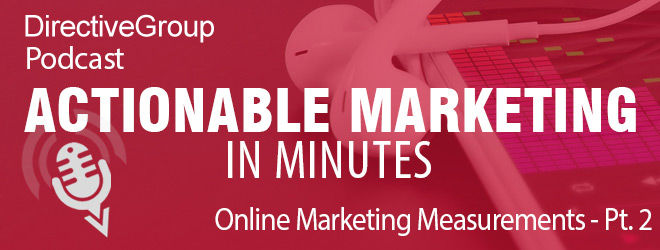In this episode of Actionable Marketing In Minutes we have part two of our discussion about online marketing measurement and attribution.
Use the player below to listen to this episode, or the download link to load it on your device for listening later. You can also find our RSS feed by clicking here, or subscribe by email in the sidebar to the left.
Download our Marketing To Millennials eBook here!
Not able to listen? Why not read the episode transcript below:
Problem
The term “segmentation” is used for several different things in marketing, but in this case we mean how your data are grouped, such that you can measure the effectiveness of you marketing efforts. In particular, this is useful in examining data within your analytics tools, such as Google Analytics. Google’s Google Analytics guru, Avinash Kaushik, says “all data in the aggregate is “crap”” – and we tend to agree with him.
There are some great tools for measuring your effectiveness online—and many tools include some default segments you can apply to any report you are looking at.
Solution
A best practice is that you should pick at least a couple of segments in each of these three categories:
1. Acquisition. 2. Behavior. 3. Outcomes.
You’ll want to focus on the micro group that is of value to your particular business within each of these categories, and then you need to apply those segments to the web analytics reports where you seek to find insights.
1) Acquisition: Acquisition refers to the activity you undertake to attract people (or search bots) to your website. This would include campaigns you run, like Pay-Per-Click marketing (PPC), SEO, email marketing, display ads, Facebook marketing campaigns etc. Essentially, you look at where you are spending your online marketing dollars, and start there. The goal of this exercise is to identify what is working and what is not, so that you can focus on ROI.
Ask yourself:
* What is high priority?
* Can I identify the segment and measure it?
* Can I build (or identify within the analytics) the appropriate reports to measure performance using KPIs?
* Do I know how to interpret this data and adjust as appropriate?
Once you have identified your acquisition segments, the reports you’ll apply them to will depend on the Key Performance Indicators (KPIs) you have chosen. Here are some of the most common KPIs:
* Visits
* New Visits
* Newsletter Sign-ups
* Bounce Rates
* Transactions
* Revenue
2) Behavior: Behavior refers to the activity people are engaged in on your website—what pages they go to, what forms they fill out, how long they stay, what pages they exit from, and if they purchase.
Ask yourself, does this behavior match your expectation? Is this what you want your site’s users to be doing on the site?
Some examples include:
* How straight of a path did they take to a conversion activity?
* Are people behaving in a consistent or surprising way?
* Did they buy? Are they a repeat buyer?
* Did they leave a review? Did they read reviews?
* Did they abandon their cart? Are the using the cart as a wish list?
* Did they come to the site via the homepage or a landing page?
The more you understand what people are doing on your site, the better you can make smart decisions on page content, navigation and quality, targeted advertising, and products.
3) Outcomes: Outcomes are site activities that you desire, such as placing an order or completing a form – and then analyze why these people had the desired outcomes when others did not.
Another way to do this is to look at all of the people who bought… which ones had extra-large transactions? What was the path through the site? What were their touchpoints? Were they mailed a coupon code? What is it about THESE people that made them such a high-value visitor?
Don’t forget that there can be smaller conversions as well, a newsletter sign-up, a video view, a wishlist add, a share… these are important too, and it starts a courting dance that you play a part in as well. What do you have for these people to keep them coming back, to keep them interested, and to bring them to the next conversion? These steps are exceedingly important as you move with your prospects and repeat customers through the sales/conversion cycle. By understanding what it is about people who deliver outcomes you can understand what to do with all those that don’t convert.
Benefits
Your website analytics tool is collecting a ton of data, and provides you the ability to collect some very useful information. In order to make smart decisions about time, money and resources when it comes to marketing, it is vital to use the tools available to capitalize on the information from your website. Use techniques such as segmentation to reach a higher level of understanding of not only your site’s performance, but your marketing dollars, and your customers’ needs. It will be a win-win-win!
We hope you’ve found this information helpful. Please connect with us on Twitter @DirectiveGroup or on LinkedIn. Let us know what you think and what you’d like to hear about next. And if you like our podcasts, please share with your networks using hashtag #actionablemarketing. Join us for an upcoming episode where we will give you some tips on how to fight against web spam.
Podcast: Play in new window | Download (Duration: 10:00 — ) | Embed
